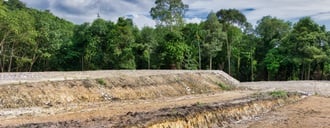Compared to the booming global sustainable debt market, the Australian market is in the early stages of growth, indicating a potentially successful future within the linked-debt market. Australian green bond issuances were up 13% in 2020, culminating in an annual record of US$305.5 billion.[i] The growing corporate loan market in Australia is today over $3 trillion Australian dollars compared to a domestic bond market of AU$1.8 trillion.[ii] Looking more broadly, we can see this trend continuing, as banks and superannuation funds globally tap into demand for green financing, leading to an increase in funds allocated to green loans and bonds.
Sustainability-Linked Instruments’ Growth in Australia
While globally the sustainable finance debt market is seeing an uptake in sustainability-linked bonds (SLB), Australia is seeing growth within the sustainability-linked loan (SLL) market. SLLs are trending because they can be applied by a wider range of borrowers than a traditional green bond or loan and can be used for general corporate purposes. This is beneficial for borrowers whose assets are not traditionally categorized as green but intend to transition towards sustainable and low-carbon business activities. (See my previous blog post for more information on SLLs and SLBs.)
Growth in the Australian SLL market is owing to the flexibility of the loan market itself. The loan structure encourages a closer relationship between lenders and borrowers and enables lenders to provide incentives for sustainability performance and to absorb any reduction in the margin of a loan. While these instruments might seem daunting for issuers who are early in their sustainability journeys, banks, such as Macquarie and ANZ are encouraging this style of loan instrument to build a closer relationship with the borrower. This lender-borrower relationship that exists within the Australian market could lead to various types of loan structures such as revolving instruments, project financing or trade facilities. Additionally, borrowers are increasingly looking towards these types of instruments to improve their sustainability profiles.
Green Deals Down Under: A Closer Look at Market Activity
Globally, the Australian SLB market stands are US$28 million in total volume of bonds, while the SLL market stands at approximately US$332 million as of April 2021.[iii] The green corporate loan market in Australia has been growing rapidly in the past two years, particularly given the sophisticated vanilla loan market structures that already exist.
Australia is the world’s eighth largest market in terms of total number of loans and bonds, having issued approximately 13 SLLs, seven SLBs and 20 combined instruments.[iv] Recent issuances within the market include: Worley (SLB), Canberra light rail (green loan), FirstMac (green mortgage-backed securities), Downer (SLL), Ramsay (SLL), Murra Warra 2 (green loan), for each of which Sustainalytics provided a second-party opinion. Other recent issuances in the market include NRG Queensland SLB (utilities), Wesfarmers SLB (retail) and Port of Newcastle SLL (ports).
The Role of Industry in the Clean Energy Transition
The Australian economy is historically embedded in heavy emitting, hard-to-abate sectors such as mining and agriculture. The sustainability-linked instrument structure provides a platform for Australian issuers to begin the journey of raising capital to reduce their emissions and pivot their business structures towards more sustainable options.
The Transition for Hard-to-Abate Industries
Agriculture makes up 2.2% of the Australian economy and mining a further 10.2%.[v] Agriculture also accounts for 25% of global GHG emissions annually and mining approximately 11%.[vi] Furthermore, the Australian energy market relies heavily on coal, oil and natural gas and despite the country’s wealth of resources, energy security concerns are on the rise. As Australia moves to reduce emissions, it is vital to ensure the stability of its economy on this path. Through these types of sustainability-linked instruments, companies now have more opportunities to accelerate their emissions reductions journey and transition towards decarbonization.
The Transition for Mining
Mining has previously not been considered as overtly ‘green’ in nature, although a recent study by the IEA highlights the importance of minerals in the transition to a low-carbon economy. [vii] As the global energy system shifts towards clean energy and associated technologies, the demand for critical minerals such as copper, lithium, nickel, cobalt and rare earth elements is increasing. Technologies such as electric vehicles require about six-times the mineral input of a conventional car and onshore wind farms require nine-times more mineral resources than a gas-fired plant. The adoption of these technologies provides an alternative opportunity for Australian companies to meet this impending shortage in minerals, for which demand is estimated to grow six-fold by 2040.
The Handbook for Success
The recently published ICMA Climate Transition Finance Handbook will help companies in hard-to-abate sectors seeking to utilize sustainability-linked instruments to advance their climate transition strategies. Globally, the market has seen issuers in heavier emitting sectors come to market through such instruments, including those in steel, utilities, shipping, and retail. Examples of such frameworks include SSAB (SLB in steel), Limak (SLB in ports), Aeroporti di Roma (SLB in airports), Ahold Delhaize (SLB in retail), Public Power (SLB in utilities), Seaspan (SLB in shipping) and H&M (SLB in retail).
What’s to Come for the Australian SLL Market
Green and sustainable finance continues to develop globally, and the Australian market is showing potential for further growth. Sustainability-linked loans are playing a pivotal role in expanding the Australian market, as lenders and borrowers cooperate to leverage financial incentives created through sustainability performance targets. For energy, chemical and mining operators, raising capital through sustainable debt affords new opportunities for decarbonization.
For Australia, an economy with roots entrenched in hard-to-abate sectors, sustainability-linked debt financing could provide the spark needed to accelerate emission reductions and transition to a low-carbon economy.
To learn more about developments in the global sustainable finance market, download our ebook “Financing Sustainability: Recent Trends in Sustainable Bonds, Loans and Disclosures.”
[i] Climate Bonds Initiative (2020), “Green Loans Australia and New Zealand,” at: https://www.environmental-finance.com/assets/files/research/Sustainability-Linked%20Debt%20in%208%20metrics.pdf
[ii] Climate Bonds Initiative (2020), “Green Loans Australia and New Zealand,” at: https://www.environmental-finance.com/assets/files/research/Sustainability-Linked%20Debt%20in%208%20metrics.pdf
[iii] Climate Bonds Initiative (2020), “Green Loans Australia and New Zealand,” at: https://www.climatebonds.net/files/reports/cbi-green-loans-aus-nz-final-14102020.pdf
[iv] Environmental Finance (2021), “Sustainability-Linked Debt in 8 metrics,” at: https://www.environmental-finance.com/assets/files/research/Sustainability-Linked%20Debt%20in%208%20metrics.pdf
[v] Department of Foreign Affairs and Trade (2020), “Trade and Investment at a glance 2020,” at: https://www.dfat.gov.au/publications/trade-and-investment/trade-and-investment-glance-2020
[vi] World Resource institute (WRI) (2019), “5 Questions About Agricultural Emissions, Answered,” at: https://www.wri.org/insights/5-questions-about-agricultural-emissions-answered
[vii] International Energy Agency (IEA) (2021), “The Role of Critical Minerals in Clean Energy Transitions,” at: https://www.iea.org/reports/the-role-of-critical-minerals-in-clean-energy-transitions/executive-summary
Recent Content
Risk and Opportunity in Biodiversity: How Sustainable Finance Can Help
This article outlines how biodiversity loss poses material risks to business and how it connects to many other issues that companies can’t ignore. In addition, it covers how biodiversity conservation presents substantial economic opportunities, and how businesses can address and access these opportunities by issuing linked instruments that integrate biodiversity considerations.
Today’s Sustainable Bond Market: Boosting Confidence in Sustainable Bond Issuances
In this article, we examine the kinds of sustainable bonds offered in the market, some of the key regulations being developed in different markets and the current initiatives to improve the quality and credibility of issuances.
Webinar Recap: How Integrating ESG Can Drive Opportunity for Private Companies
Recently, Morningstar Sustainalytics hosted a webinar – ESG in the Lifecycle of a Private Company: How Stakeholder Demands Drive Sustainability in Private Markets – to address some of the questions private companies might have surrounding ESG and how it could impact their business.




